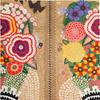'Beadwork Adorns the World' Opening in April at Museum of International Folk Art
- SANTA FE, New Mexico
- /
- January 18, 2018
The ultimate migrants, small glass beads travel the world and end up entering the cultural lives of people far away to be worked into a garment or an object of art. This spring, the Museum of International Folk Art in Santa Fe presents the exhibition, Beadwork Adorns the World, opening April 22, 2018 and running through February 3, 2019.
Whether these extraordinary glass beads come from the island of Murano (Venice, Italy) or the mountains of Bohemia (Czech Republic), where they start out is seldom where they end up. No matter where they originate, the locale that uses them makes them into something specific to their own world view.
This exhibition is about what happens to these beads when they arrive at their final destination, whether it be the African continent (Botswana, Cameroon, the Democratic Republic of the Congo, Ghana, Kenya, Nigeria, South Africa), to Borneo, to Burma, to India, Native North America to Latin America (Mexico, Bolivia to Ecuador).
“Even though it’s titled Beadwork Adorns the World, this exhibit is not actually about beads,” said Khristaan Villela, Ph.D, Director of the Museum of International Folk Art.
According to Guest Curator, Dr. Marsha Bol, “It is about working beads resulting in beadwork, and what a collective of beads in a garment or an object reveals about the intentions of its makers or users.
In most parts of the world, beads, having value, are used at peak moments in life. With their luster and sparkle, used as an adornment or surface additive, they help to heighten the effect, the impact, the meaning. These special moments in the life of the community tend to revolve around:
- life stages and passages - such as birth, becoming an adult, marriage, and death
- power, position, or status in the community
- the high meaning of the occasion - as seen in fine dress, house and animal decoration
- communication with the spirits
Very few cultures have ever lived in total isolation from other peoples. Contact with others beyond the village allows for new markets and new uses for beadwork, as well as opportunities to survive creatively.
Not all beads used in the beadwork in this exhibit are made of glass. Beads made from metal, cloth, shell, stone, and other materials worked into objects served equally well to distinguish their wearer.
While beadwork has a lengthy history, it is truly a living art. Although the majority of the art works in this exhibit date from the 19th – 20st centuries, there are many 21st century examples. Beadwork today comes in many forms – it may be a continuation of an unbroken tradition, perhaps with contemporary innovations, or it may be a revival of a lost form or something entirely new.




_-Closing-the-Distance_100x100_c.jpg)











